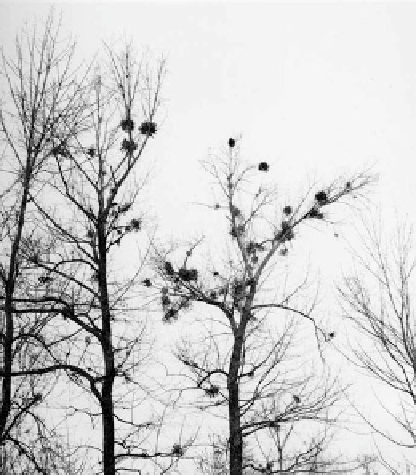Biology Reference
In-Depth Information
Phoradendron serotinum (
flavescens
).
East-
ern Mistletoe
, from southern New Jersey west to
Ohio and Missouri and south to the Gulf, on many
hardwoods - oaks, elm, maple, sycamore, gums,
hickory, pecan, hackberry, hawthorn, persim-
mon, black locust, western soapberry, sassafras,
and trumpet-vine. This species has white berries
and is the common Christmas mistletoe.
Phoradendron tomentosum
Texas Mistle-
toe
, abundant in Texas on elms, oaks, mesquite,
osage-orange, and sugarberry; has white berries.
Phoradendron villosum
Hairy Mistletoe
,
ranging from Oregon through California, usually
on oaks, also on Oregon myrtle, California buck-
eye, chestnut, and manzanitas. It has pinkish
white berries and may cause large hypertrophies
on oaks.
Fig. 1
Mistletoe, common in southern trees
Viscum (True Mistletoe)
The genus is restricted to California. It is now
known that Luther Burbank introduced the para-
site into the state in about 1900. Burbank's notes
indicate that seed was supplied to him by J. C.
Vaughan of Chicago, Illinois. This mistletoe has
spread about 3.5 miles in 75 years.
Viscum album
European Mistletoe
, on alder,
ash, birch, hawthorn, hickory, buckeye, maple,
mountain ash, pear, persimmon, plum, poplar,
pyracantha, willow, crabapple, and elm.
Phoradendron (True Mistletoe)
Phoradendron means tree thief. The genus is
restricted to the Americas, ranging from southern
New Jersey and Oregon southward. Most are on
hardwoods.
Phoradendron californicum
California-
Mistletoe
, ranging from southern California to
Arizona, chiefly on Leguminosae - mesquite,
carob, squaw-bush, creosotebush, parkinsonia.
This is a leafless species, generally pendent,
with long stems and reddish pink berries.
Phoradendron juniperinum
Juniper Mistle-
toe
, a leafless species with straw-or wine-colored
berries, ranging from Colorado and Utah through
New Mexico and Arizona.
Phoradendron libocedri
Incense Cedar Mis-
tletoe
, confined to incense cedar and occurring
throughout its range in Oregon, California, and
Nevada. The pendent plants are leafless with
straw-colored berries. It may injure plants
severely, causing spindle-shaped swellings in
limbs at point of attack and living in the trunk
as a parasite for hundreds of years after external
portions have disappeared.
Arceuthobium (Dwarf Mistletoe)
The genus is restricted to conifers, and most
species are found in the Northwest. Trees of any
age may be deformed or killed, but the greatest
mortality is among seedlings and saplings, with
lodgepole and ponderosa pines most susceptible.
The most striking symptom is the formation of
witches' broom, with sometimes the whole crown
transformed into a huge broom. In other cases
fusiform swellings in trunks turn into cankers.
Foliage of affected trees is reduced.
The mistletoes themselves are small, rarely
attaining a maximum of 8 inches, sometimes
less than an inch. They are pereninal shoots,





